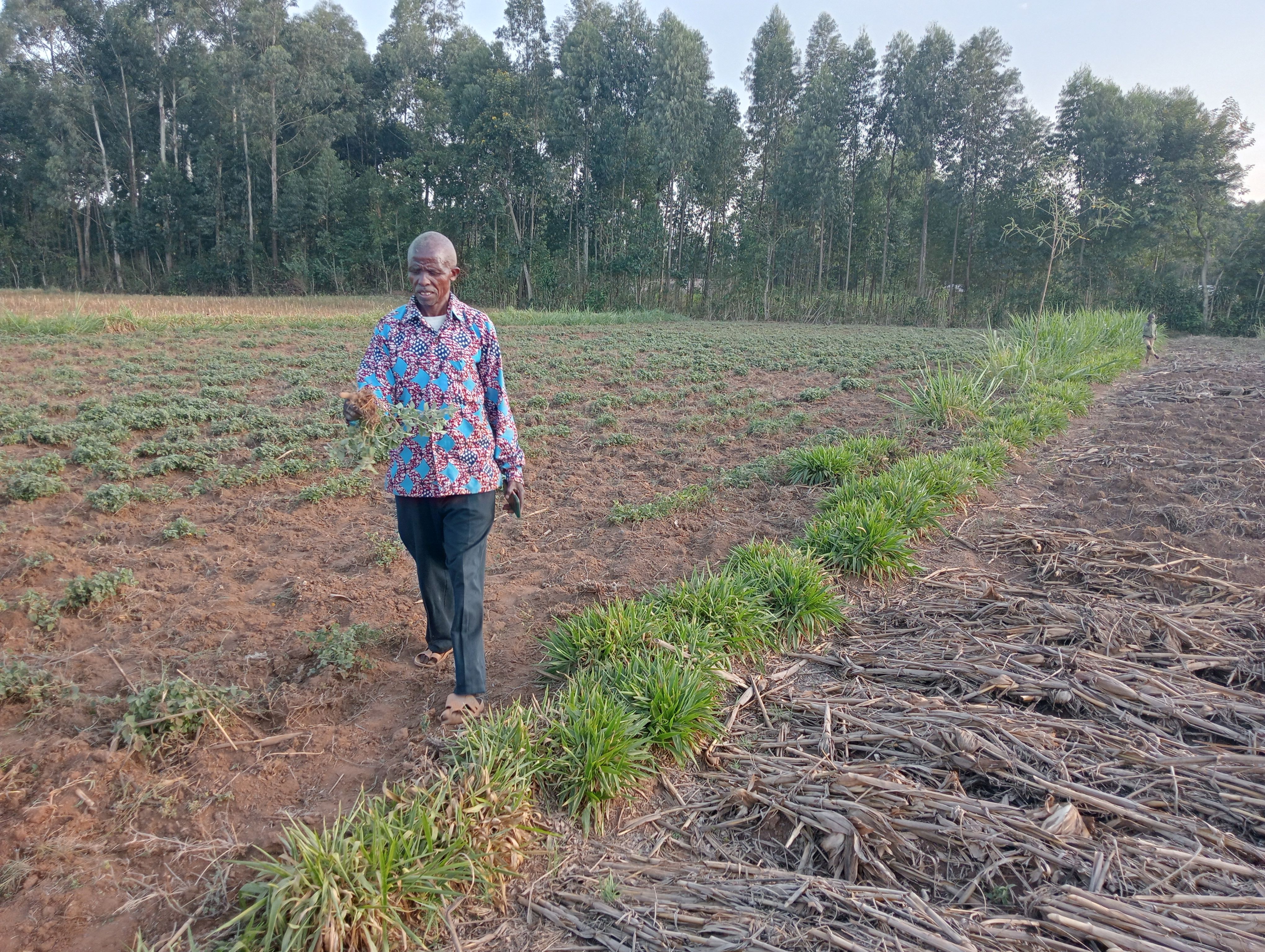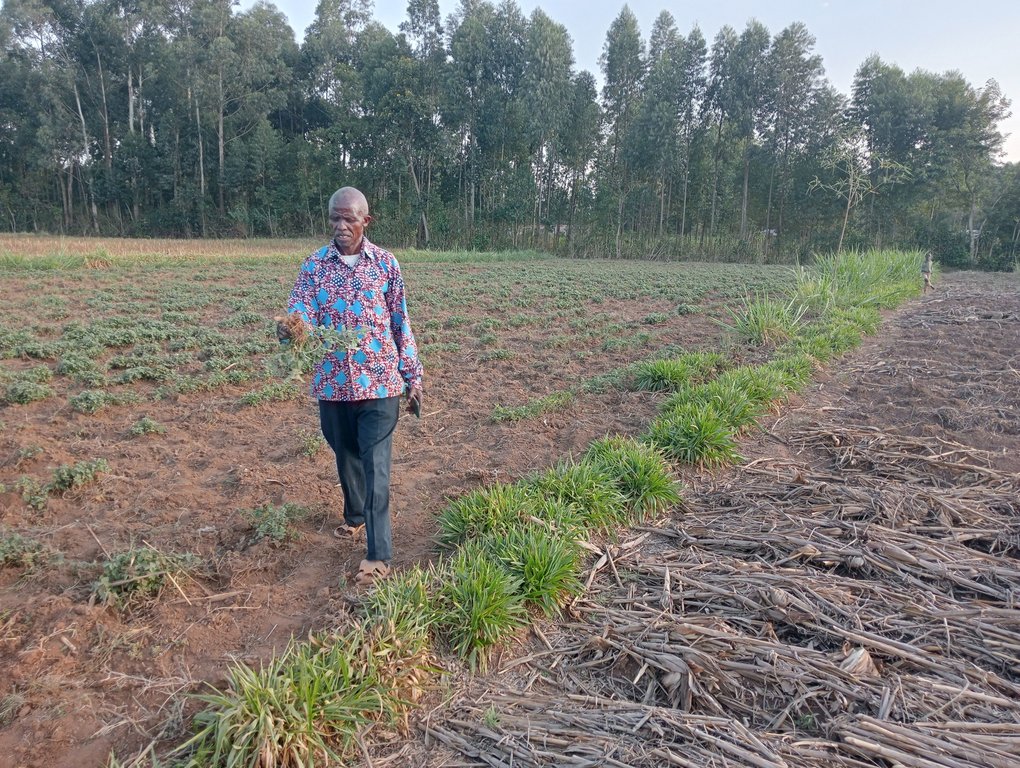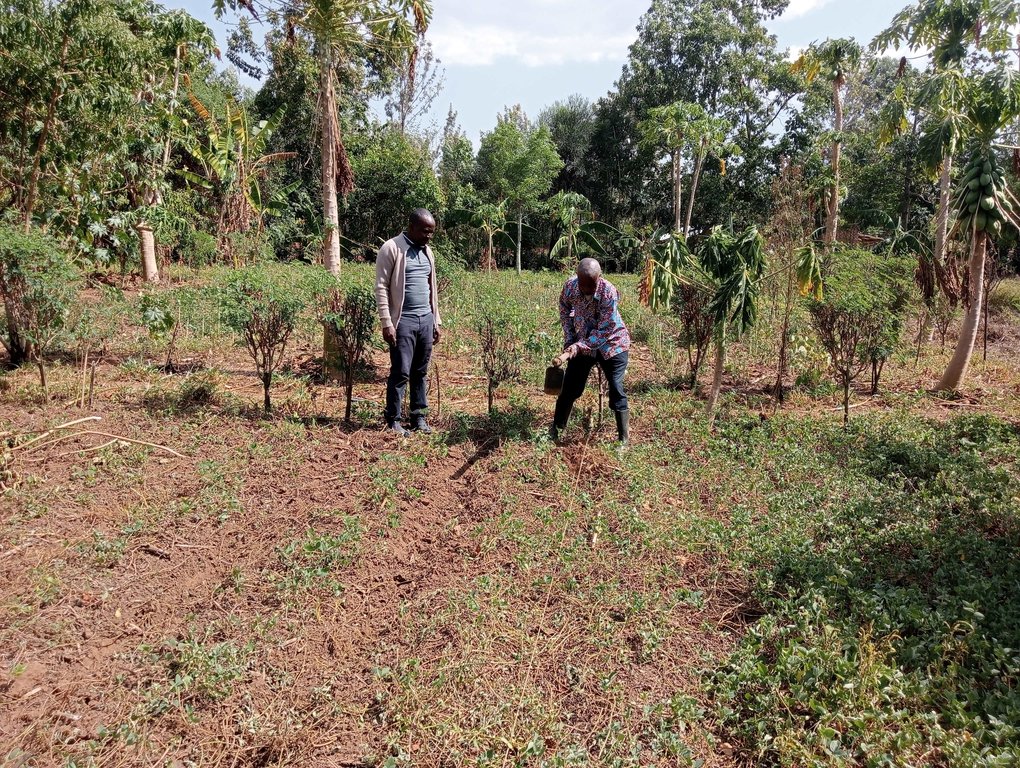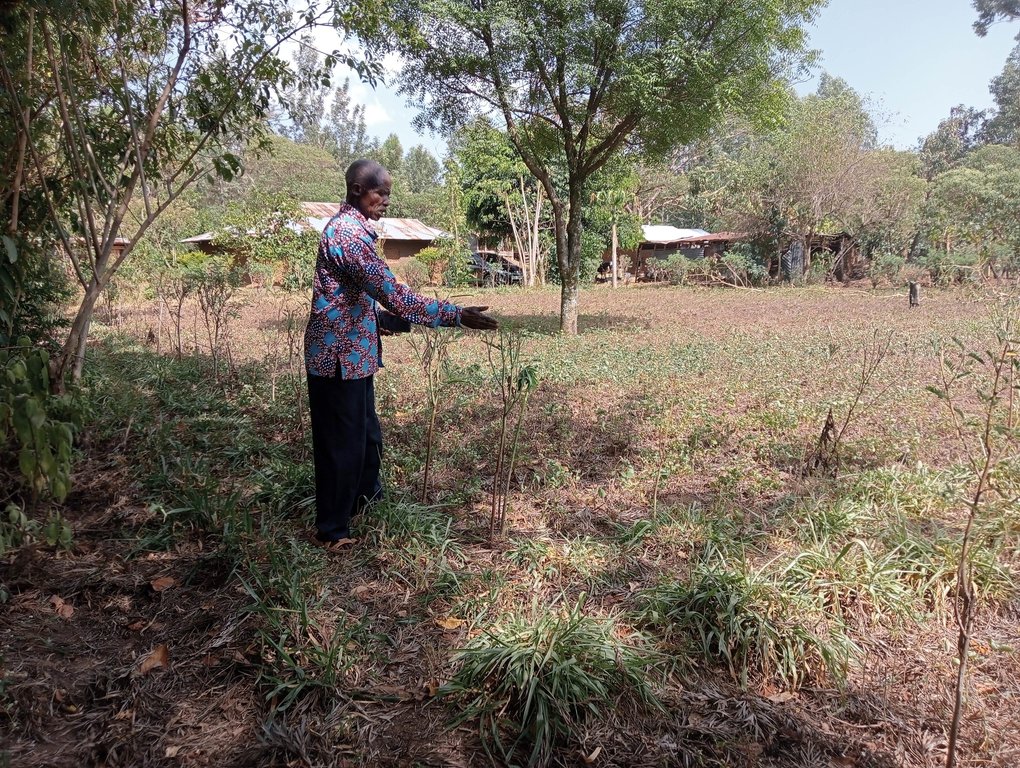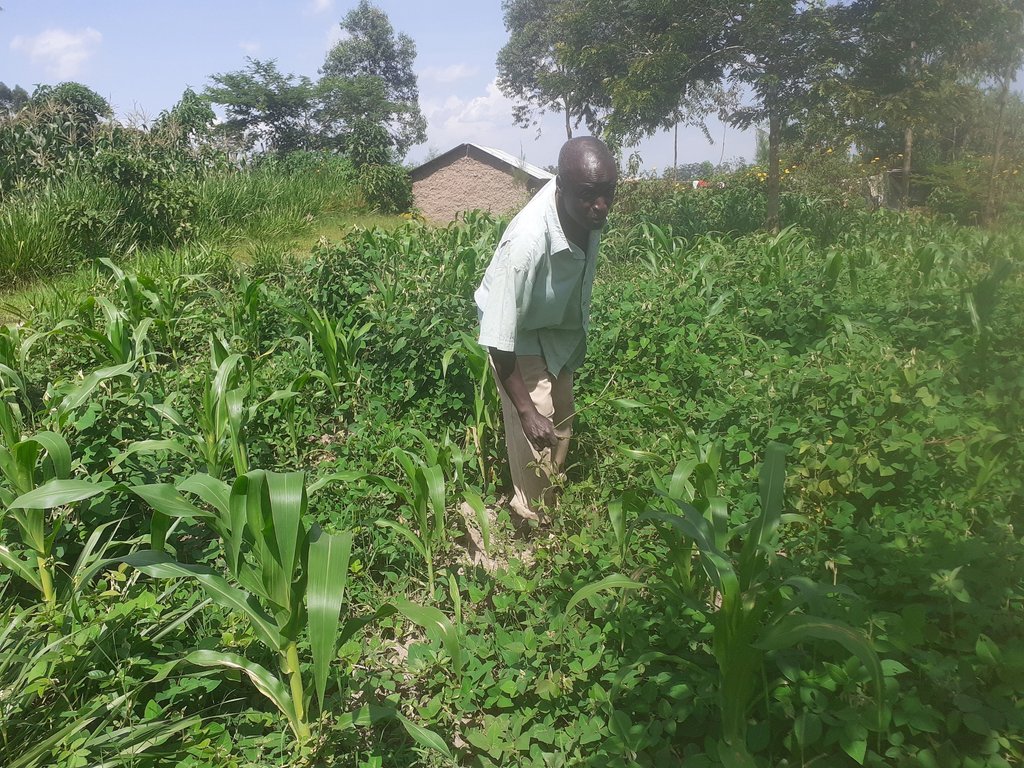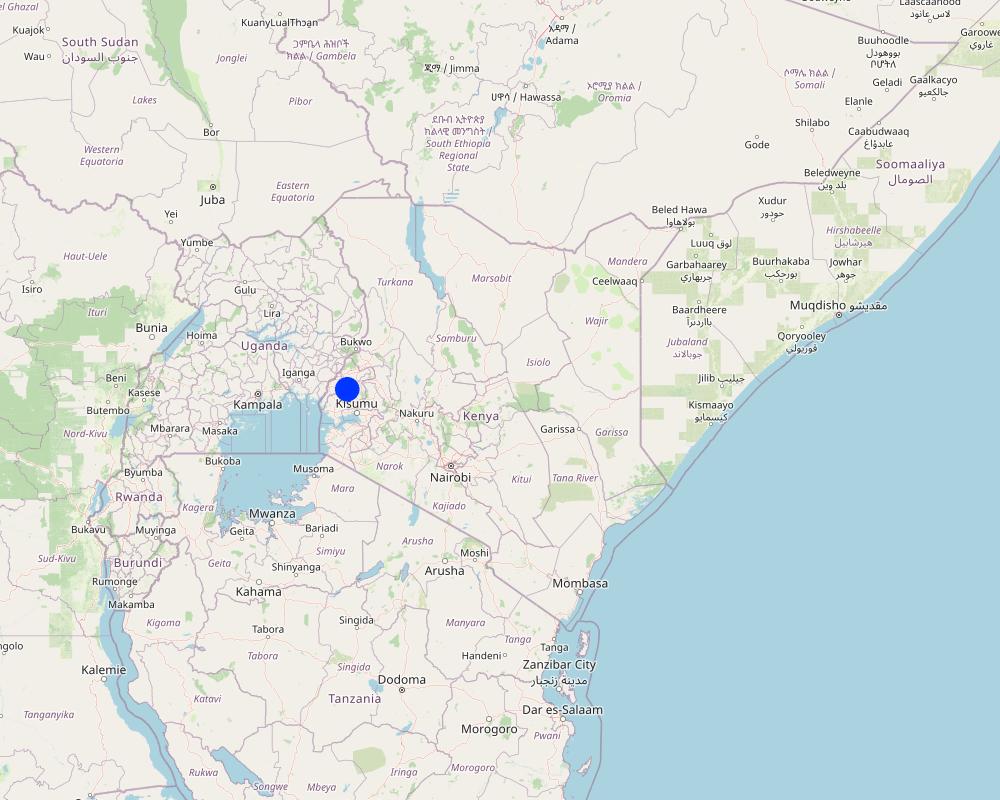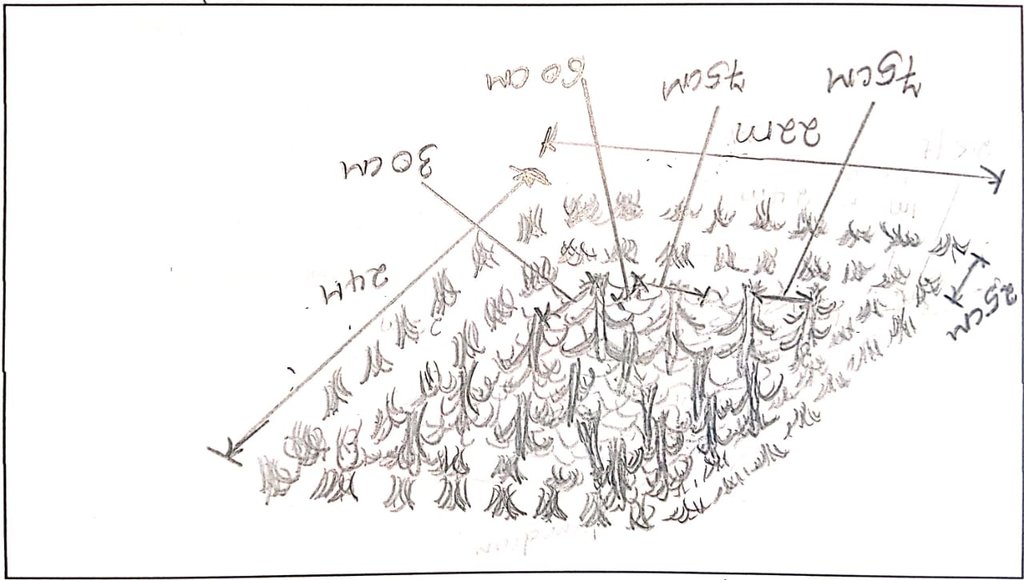Push-pull crop pest control [ប្រទេសកេនយ៉ា]
- ការបង្កើត៖
- បច្ចុប្បន្នភាព
- អ្នកចងក្រង៖ William Akwanyi
- អ្នកកែសម្រួល៖ George Onyango, Innocent Faith, Noel Templer, JUSTINE OTSYULA, Tabitha Nekesa, Ahmadou Gaye, Siagbé Golli
- អ្នកត្រួតពិនិត្យច្រើនទៀត៖ William Critchley, Rima Mekdaschi Studer, Sally Bunning
technologies_6701 - ប្រទេសកេនយ៉ា
ពិនិត្យមើលគ្រប់ផ្នែក
ពង្រីកមើលទាំងអស់ បង្រួមទាំងអស់1. ព័ត៌មានទូទៅ
1.2 ព័ត៌មានលម្អិតពីបុគ្គលសំខាន់ៗ និងស្ថាប័នដែលចូលរួមក្នុងការវាយតម្លៃ និងចងក្រងឯកសារនៃបច្ចេកទេស
បុគ្គលសំខាន់ម្នាក់ (ច្រើននាក់)
អ្នកប្រើប្រាស់ដី:
Keya Andrew Mulaa
Welthungerhilfe farmer
ប្រទេសកេនយ៉ា
អ្នកជំនាញឯកទេស SLM:
អ្នកជំនាញឯកទេស SLM:
ឈ្មោះគម្រោងដែលបានចងក្រងឯកសារ/ វាយតម្លៃលើបច្ចេកទេស (បើទាក់ទង)
Soil protection and rehabilitation for food security (ProSo(i)l)ឈ្មោះអង្គភាពមួយ (ច្រើន) ដែលបានចងក្រងឯកសារ/ វាយតម្លៃបច្ចេកទេស (បើទាក់ទង)
Deutsche Gesellschaft für Internationale Zusammenarbeit (GIZ)ឈ្មោះអង្គភាពមួយ (ច្រើន) ដែលបានចងក្រងឯកសារ/ វាយតម្លៃបច្ចេកទេស (បើទាក់ទង)
CIAT International Center for Tropical Agriculture (CIAT International Center for Tropical Agriculture) - ប្រទេសកេនយ៉ា1.3 លក្ខខណ្ឌទាក់ទងទៅនឹងការប្រើប្រាស់ទិន្នន័យដែលបានចងក្រងតាមរយៈ វ៉ូខេត
អ្នកចងក្រង និង(បុគ្គលសំខាន់ៗ)យល់ព្រមទទួលយកនូវលក្ខខណ្ឌនានាទាក់ទងទៅនឹងការប្រើប្រាស់ទិន្នន័យដែលបានចងក្រងតាមរយៈវ៉ូខេត:
បាទ/ចា៎
1.4 សេចក្តីប្រកាសស្តីពីចីរភាពនៃការពណ៌នាពីបច្ចេកទេស
តើបច្ចេកទេសដែលបានពណ៌នានេះមានបញ្ហាដែលផ្តោតលើការធ្លាក់ចុះគុណភាពដី, បើដូច្នេះវាមិនអាចត្រូវបានប្រកាសថាជាបច្ចេកទេសនៃការគ្រប់គ្រងប្រកបដោយចីរភាពទេ?
ទេ
មតិយោបល់:
The technology has not adversely affected the farms of farmers who have implemented the technology.
2. ការពណ៌នាពីបច្ចេកទេស SLM
2.1 ការពណ៌នាដោយសង្ខេបពីបច្ចេកទេស
និយមន័យបច្ចេកទេស:
Push-pull technology is a strategy that controls pests, improves the productivity of cereal crops and fodder, and controls soil erosion.
2.2 ការពណ៌នាលម្អិតពីបច្ចេកទេស
ការពណ៌នា:
Push–pull technology was developed by the International Centre of Insect Physiology and Ecology (ICIPE) in collaboration with Rothamsted Research, (UK) in Kenya in the 1990s for the control of stemborer and striga weed in resource-poor maize farming systems. It is a strategy for controlling pests by using plants that repel them i.e., “push” crops and plants that trap pests i.e., “pull” crops. In Kakamega, Siaya, and Bungoma counties of western Kenya (i.e., the ProSoil project areas), the production of maize, millet, and sorghum has greatly been affected by poor soil fertility; insect pests, especially stemborer; and a parasitic weed called striga. Under the ProSoil project, Desmodium intortum is the main repellent “push” crop while napier grass (Pennisetum purpureum), brachiaria (Brachiaria decumbens), and mulatto (Brachiaria ruziziensis) are the main “pull” or trap plants.
In a typical push-pull system, the attractant “pull” plant is planted as a border around the field where the main crop e.g., maize, millet, or sorghum has been intercropped with the “push” crop. Desmodium produces repellent volatile chemicals that push away stemborer moths from the main field towards the edge where there is the “pull” or trap crop. The attractant trap plant emits volatile compounds which serve as a haven for the stemborers. As the stemborer moths lay eggs on the pull/ trap plant (in this case bracharia) and the eggs hatch and develop into larvae or caterpillar stage, a sticky substance like glue secreted by the bracharia physically traps the larvae; hence, inhibiting further development. In addition, desmodium stimulates the germination of striga and then effectively inhibits its growth through its roots' exudates.
“Push-pull” technology improves the productivity of cereal crops, controls soil erosion, and contributes to conservation agriculture (minimum tillage). Desmodium and bracharia are both high-quality animal fodder plants and because of their perennial nature, they maintain ground cover. Bracharia is rich in crude protein. Desmodium is a leguminous green manure cover crop and, therefore, it fixes nitrogen in the soil and improves soil organic matter. Desmodium does not suppress the main crop since it is not a climber.
One acre (0.4 ha) of land (in a push-pull system) requires about 0.75 kg of desmodium seeds and about 0.5 kg of brachiaria seeds. Desmodium is planted at a spacing of 75 cm between rows and 60 cm between plants in the same row. The cereal crop is established in rows parallel to the desmodium crop rows (e.g., 75 cm from row to row and 30 cm from plant to plant in the same row for maize). Brachiaria is planted in two shallow trenches (50 cm apart) and because the seeds are very tiny, they are sown on the surface of the trenches and covered with a very thin layer of soil to keep them in place, in darkness, until they sprout. They are later thinned to give a spacing of 25 cm between plants.
2.3 រូបភាពនៃបច្ចេកទេស
2.4 វីដេអូនៃបច្ចេកទេស
ការពណ៌នាសង្ខេប:
https://www.youtube.com/watch?v=QbX1RWBGZI4&ab_channel=WilliamOnura
A farmer demonstrating how to prune desmodium roots using an African sword and how to break the ground/ soil using a chaka hoe.
កាលបរិច្ឆេទ:
11/02/2023
ទីតាំង:
Andrew Mulla's farm in Lunyu Village, Khalaba Ward, Matungu Sub-county, in Kakamega County
ឈ្មោះអ្នកថតវីឌីអូ:
William Akwanyi
2.5 ប្រទេស/តំបន់/ទីតាំងកន្លែង ដែលបច្ចេកទេសត្រូវបានអនុវត្ត និងបានគ្រប់ដណ្តប់ដោយការវាយតម្លៃនេះ
ប្រទេស:
ប្រទេសកេនយ៉ា
តំបន់/រដ្ឋ/ខេត្ត:
Kakamega County in western Kenya
បញ្ជាក់បន្ថែមពីលក្ខណៈនៃទីតាំង:
Khalaba Ward, Matungu Sub-county, in Kakamega County
បញ្ជាក់ពីការសាយភាយនៃបច្ចេកទេស:
- ត្រូវបានផ្សព្វផ្សាយត្រឹមតំបន់មួយ
ប្រសិនបើមិនច្បាស់ពីទំហំផ្ទៃដី សូមធ្វើការប៉ាន់ប្រម៉ាណ:
- < 0.1 គម2 (10 ហិកតា)
តើបច្ចេកទេស (មួយ ឬច្រើន) ទាំងនោះស្ថិតនៅក្នុងតំបន់ការពារជាអចិន្ត្រៃយ៍ណាមួយដែរឬទេ?
ទេ
មតិយោបល់:
There are no protected areas in the areas covered by this assessment. The stated area is the total area of the two fields where the information that was used in this documentation was collected from. Only one field (Andrew's) was used for most of the documentation e.g., field measurements and costs estimation. Nice photos of the technology were taken in the other field (Patrick's).
Map
×2.6 កាលបរិច្ឆេទនៃការអនុវត្ត
បង្ហាញឆ្នាំនៃការចុះអនុវត្ត:
2019
2.7 ការណែនាំពីបច្ចេកទេស
សូមបញ្ជាក់តើបច្ចេកទេសត្រូវបានណែនាំឱ្យអនុវត្តដោយរបៀបណា:
- តាមរយៈគម្រោង / អន្តរាគមន៍ពីខាងក្រៅ
មតិយោបល់ (ប្រភេទនៃគម្រោង ។ល។):
Technology introduced by the ProSoil project.
3. ចំណាត់ថ្នាក់នៃបច្ចេកទេស SLM
3.1 គោលបំណងចម្បង (១ ឬច្រើន) នៃបច្ចេកទេសនេះ
- ធ្វើឱ្យប្រសើរឡើងនូវផលិតកម្ម
- អភិរក្ស/ធ្វើឱ្យប្រសើរឡើងជីវចម្រុះ
- បន្ស៊ាំទៅនឹងការប្រែប្រួលអាកាសធាតុ/គ្រោះមហន្តរាយ និងផលប៉ះពាល់របស់វា
- កាត់បន្ថយការប្រែប្រួលអាកាសធាតុ និងផលប៉ះពាល់របស់វា
- បង្កើតផលប្រយោជន៍សេដ្ឋកិច្ច
3.2 ប្រភេទដីប្រើប្រាស់មួយប្រភេទ (ច្រើនប្រភេទ) ដែលបានអនុវត្តបច្ចេកទេស
ដីប្រើប្រាស់ចម្រុះនៅលើដីតែមួយ:
បាទ/ចា៎
បញ្ជាក់ពីប្រភេទដីច្រើនប្រភេទ (ដីដាំដំណាំ/ដីចិញ្ចឹមសត្វ/ដីព្រៃឈើ):
- ដាំដំណាំ ចិញ្ចឹមសត្វ និងឈើ

ដីដាំដំណាំ
- ដំណាំប្រចាំឆ្នាំ
- ដំណាំរយៈពេលវែង (មិនមែនឈើ)
- ប្រភេទដើមឈើធំៗ និងដើមឈើតូចៗ
ដំណាំប្រចាំឆ្នាំ - បញ្ជាក់ប្រភេទដំណាំ:
- ដំណាំចំណីសត្វ - ស្មៅ
- ដំណាំចំណីសត្វ - ចន្ទល់ភ្នំ
- ធញ្ញជាតិ - ពោត
- ធញ្ញជាតិ - ពោតសាលី
- បន្លែ - ផ្សេងៗ
- ពពួកសណ្តែក - សណ្តែកបារាំង
ប្រព័ន្ធដាំដុះដំណាំប្រចាំឆ្នាំ:
ការដាំពពួកសណ្តែកចន្លោះ ពោត /sorghum/millet
ដំណាំរយៈពេលវែង (មិនមែនឈើ) - បញ្ជាក់ប្រភេទដំណាំ:
- ចេក/plantain/abaca
- អំពៅ
- ដំណាំចំណីសត្វ - ស្មៅ
- fodder crops - legumes, clover
ប្រភេទដើមឈើធំៗ និងដើមឈើតូចៗ - បញ្ជាក់ប្រភេទ:
- ដំណាំចំណី (Calliandra, Leucaena leucocephala, Prosopis, etc.)
- ផ្លែប៊ឺ
- ផ្លែឈើផ្សេងៗ
- ផ្លែស្វាយ/ផ្លែមង្ឃុត/ផ្លែត្របែក
- ផ្លែល្ហុង
ចំនួនសារដែលដាំដំណាំក្នុងមួយឆ្នាំ:
- 2
សូមបញ្ជាក់:
Crops are grown during the long and short rain seasons.
តើជាការអនុវត្តន៍ដំណាំចន្លោះ?
បាទ/ចា៎
ប្រសិនបើបាទ/ច៎ា សូមបញ្ជាក់ប្រភេទដំណាំដែលដាំចន្លោះគ្នានោះ:
Cereal and legumes.
តើជាការអនុវត្តន៍ដំណាំវិលជុំ?
បាទ/ចា៎
បើបាទ/ច៎ា សូមបញ្ជាក់:
The push-pull plot is left fallow with only the repellant and attractant crops.

ដីសម្រាប់ចិញ្ចឹមសត្វ
ដីវាលស្មៅតូចៗ/ ផលិតកម្មចំណី:
- កាត់ និងជញ្ជូន/ គ្មានវាលស្មៅសម្រាប់ចិញ្ចឹមសត្វ
- បង្កើនវាលស្មៅ
ប្រភេទសត្វ:
- សត្វពាហនៈ - សត្វចិញ្ចឹមយកទឹកដោះ
- សត្វពពែ
- បសុបក្សី
តើជាការអនុវត្តការគ្រប់គ្រងដែលរួមបញ្ចូលការដាំដំណាំ និងចិញ្ចឹមសត្វដែរឬទេ?
បាទ/ចា៎
បើបាទ/ច៎ា សូមបញ្ជាក់:
Desmodium and napier grass are fodder crops - fed to livestock. Manure from the animals is applied on the cereal crops.
ផលិតផល និងសេវាកម្ម:
- economic security, investment prestige
- ទឹកដោះគោ
- manure as fertilizer/ energy production
- ស៊ុត
- សាច់
ប្រភេទពូជ:
សត្វពាហនៈ - សត្វចិញ្ចឹមយកទឹកដោះ
ចំនួន:
3
ប្រភេទពូជ:
បសុបក្សី
ចំនួន:
55
ប្រភេទពូជ:
សត្វពពែ
ចំនួន:
4
3.3 បន្ទាប់ពីអនុវត្តបច្ចេកទេស តើដីប្រើប្រាស់មានការប្រែប្រួលដែររឺទេ?
បន្ទាប់ពីអនុវត្តបច្ចេកទេស តើដីប្រើប្រាស់មានការប្រែប្រួលដែររឺទេ?
- ទេ (បន្តទៅសំណួរ 3.4)
3.4 ការផ្គត់ផ្គង់ទឹក
ការផ្គត់ផ្គង់ទឹកនៅកន្លែងអនុវត្តបច្ចេកទេស:
- ទឹកភ្លៀង
មតិយោបល់:
Crop establishment is dependent on availability of rainfall.
3.5 ក្រុម SLM ដែលបច្ចេកទេសស្ថិតនៅក្នុង
- ប្រព័ន្ធដំណាំបង្វិល (ការដាំដំណាំវិលជុំ ការទុកដីចោលដើម្បីបង្កើនជីជាតិ កសិកម្មពនេចរ)
- ការគ្រប់គ្រងដោយរួមបញ្ចូលការដាំដំណាំ និងការចិញ្ចឹមសត្វ
- បញ្ចូលការគ្រប់គ្រងសត្វល្អិត និងជំងឺតាមបែបចម្រុះ (រួមទាំង កសិកម្មសរីរាង្គ)
3.6 វិធានការ SLM ដែលបញ្ចូលនូវបច្ចេកទេស

វិធានការក្សេត្រសាស្ត្រ
- A1: ដំណាំ/គម្របដី
- A2: សារធាតុសរីរាង្គ/ជីជាតិដី
- A3: ការរក្សាស្រទាប់ដីខាងលើ

វិធានការរុក្ខជាតិ
- V2: ស្មៅនិងរុក្ខជាតិៗដែលដុះមានអាយុមិនលើសពី 2ឆ្នាំ
3.7 កំណត់ប្រភេទនៃការធ្លាក់ចុះគុណភាពដីសំខាន់ៗដែលបច្ចេកទេសនេះបានដោះស្រាយ

ការហូរច្រោះដីដោយសារទឹក
- Wt: ការបាត់ដីស្រទាប់លើដោយការហូរច្រោះ

ការបាត់ដីដោយសារខ្យល់
- Et: ការបាត់បង់ដីស្រទាប់លើ
3.8 ការពារ កាត់បន្ថយ ឬស្តារឡើងវិញនៃការធ្លាក់ចុះគុណភាពដី
បញ្ជាក់ពីគោលដៅរបស់បច្ចេកទេស ដែលផ្តោតទៅការធ្លាក់ចុះគុណភាពដី:
- ការការពារការធ្លាក់ចុះគុណភាពដី
4. បច្ចេកទេសជាក់លាក់ សកម្មភាពអនុវត្ត ធាតុចូល និងថ្លៃដើម
4.1 គំនូសបច្ចេកទេសនៃបច្ចេកទេសនេះ
លក្ខណៈពិសេសនៃបច្ចេកទេស (ទាក់ទងនឺងគំនូរបច្ចេកទេស):
Trap crop at the edge (brachiaria): 50 cm x 25 cm
Repellant crop (desmodium): 75 cm x 60 cm
Cereal crop (maize intercropped with desmodium): 75 cm x 30 cm
ឈ្មោះអ្នកនិពន្ធ:
William Akwanyi
កាលបរិច្ឆេទ:
11/02/2023
4.2 ព័ត៌មានទូទៅដែលពាក់ព័ន្ធនឹងការគណនាធាតុចូល និងថ្លៃដើម
កំណត់របៀបនៃការគណនាថ្លៃដើម និងធាតុចូល:
- ក្នុងតំបន់អនុវត្តបច្ចេកទេស
កំណត់ទំហំ និងឯកត្តាផ្ទៃដី:
0.0528 ha
ផ្សេងៗ/ រូបិយប័ណ្ណជាតិ (បញ្ជាក់):
KES
បើពាក់ព័ន្ធសូមកំណត់អត្រាប្តូរប្រាក់ពីដុល្លាទៅរូបិយប័ណ្ណតំបន់ (ឧ. 1 ដុល្លារ = 79.9 រៀលនៃរូបិយប័ណ្ណប្រេស៊ីល) ៖ 1 ដុល្លារ =:
124,21
កំណត់ថ្លៃឈ្នួលជាមធ្យមនៃការជួលកម្លាំងពលកម្មក្នុងមួយថ្ងៃ:
KES 250.00
4.3 សកម្មភាពបង្កើត
| សកម្មភាព | រយៈពេល (រដូវកាល) | |
|---|---|---|
| 1. | Land preparation | Before rains |
| 2. | Seed sourcing | Before rains |
| 3. | Planting | After rains |
មតិយោបល់:
Land should be ploughed only when there are stubborn weeds.
4.4 ថ្លៃដើម និងធាតុចូលដែលត្រូវការសម្រាប់ការបង្កើតបច្ចេកទេស
| បញ្ជាក់ពីធាតុចូល | ឯកតា | បរិមាណ | ថ្លៃដើមក្នុងមួយឯកតា | ថ្លៃធាតុចូលសរុប | % នៃថ្លៃដើមដែលចំណាយដោយអ្នកប្រើប្រាស់ដី | |
|---|---|---|---|---|---|---|
| កម្លាំងពលកម្ម | Land preparation | Man-days | 4,0 | 250,0 | 1000,0 | 100,0 |
| សម្ភារៈ | Slasher | No. | 1,0 | 70,0 | 70,0 | |
| សម្ភារៈ | African machete (panga) | No. | 1,0 | 80,0 | 80,0 | |
| សម្ភារៈ | Jab planter | No. | 1,0 | 1000,0 | 1000,0 | |
| សម្ភារៈដាំដុះ | Bracharia seeds | Kgs | 0,1 | 420,0 | 42,0 | |
| សម្ភារៈដាំដុះ | Desmodium seeds | Kgs | 0,26 | 420,0 | 109,2 | |
| សម្ភារៈដាំដុះ | Maize seeds | Kgs | 1,0 | 180,0 | 180,0 | 100,0 |
| ជី និងសារធាតុពុល | Manure | Wheelbarrows | 30,0 | 70,0 | 2100,0 | |
| ថ្លៃដើមសរុបក្នុងការបង្កើតបច្ចេកទេស | 4581,2 | |||||
| ថ្លៃដើមសរុបក្នុងការបង្កើតបច្ចេកទេសគិតជាដុល្លារ | 36,88 | |||||
ប្រសិនបើអ្នកប្រើប្រាស់ដីមិនមានថ្លៃដើម 100% សូមបញ្ជាក់ថានរណាដែលចំណាយថ្លៃដើមដែលនៅសល់:
ProSoil project through Welthungerhilfe.
មតិយោបល់:
The ProSoil project through Welthungerhilfe provided slashers, African swords, and jab planters to the farmers through their groups. The costs of these implements are KES 350/- for a slasher, KES 400/- for a panga (machete), and KES 5,000/- for a jab planter. It is assumed that the farmer will be able to use these implements over a period of 5 years before these implements will have depreciated to a point where they will not be useable. The cost is thus spread over the years when the farmer will be able to use the implement.
4.5 សកម្មភាពថែទាំ
| សកម្មភាព | ពេលវេលា/ ភាពញឹកញាប់ | |
|---|---|---|
| 1. | Shallow weeding | Twice during maize crop growing period |
| 2. | Ripping | Before maize re-establishement |
| 3. | Root management | Before maize re-establishement |
4.6 កំណត់ថ្លៃដើមសម្រាប់ការថែទាំ/ សកម្មភាពរបស់បច្ចេកទេស (ក្នុងរយៈពេលមួយឆ្នាំ)
| បញ្ជាក់ពីធាតុចូល | ឯកតា | បរិមាណ | ថ្លៃដើមក្នុងមួយឯកតា | ថ្លៃធាតុចូលសរុប | % នៃថ្លៃដើមដែលចំណាយដោយអ្នកប្រើប្រាស់ដី | |
|---|---|---|---|---|---|---|
| កម្លាំងពលកម្ម | Shallow weeding | Man-days | 2,0 | 250,0 | 500,0 | |
| កម្លាំងពលកម្ម | Root management | Man-days | 2,0 | 250,0 | 500,0 | |
| កម្លាំងពលកម្ម | Ripping | Man-days | 4,0 | 250,0 | 1000,0 | |
| សម្ភារៈ | Shallow weeder | No. | 1,0 | 80,0 | 80,0 | |
| សម្ភារៈ | Chaka hoe | No. | 1,0 | 130,0 | 130,0 | |
| សម្ភារៈ | African machete (panga) | No. | 1,0 | 80,0 | 80,0 | |
| ថ្លៃដើមសរុបសម្រាប់ការថែទាំដំណាំតាមបច្ចេកទេស | 2290,0 | |||||
| ថ្លៃដើមសរុបសម្រាប់ការថែទាំដំណាំតាមបច្ចេកទេសគិតជាដុល្លារ | 18,44 | |||||
ប្រសិនបើអ្នកប្រើប្រាស់ដីមិនមានថ្លៃដើម 100% សូមបញ្ជាក់ថានរណាដែលចំណាយថ្លៃដើមដែលនៅសល់:
ProSoil project through Welthungerhilfe.
មតិយោបល់:
The ProSoil project through Welthungerhilfe provided Shallow weeders, pangas (machete), and chaka hoes to the farmers through their groups. The costs of these implements are KES 400/- for a slasher, KES 400/- for an African sword, and KES 650/- for a jab planter. It is assumed that the farmer will be able to use these implements over a period of 5 years before these implements will have depreciated to a point where they will not be useable. The cost is thus spread over the years when the farmer will be able to use the implement.
4.7 កត្តាសំខាន់បំផុតដែលមានឥទ្ធិពលដល់ការចំណាយ
ពណ៌នាពីកត្តាប៉ះពាល់ចម្បងៗទៅលើថ្លៃដើម:
Rate of man-days vary from one place to another, farmer to farmer, and with type of work.
Exchange rate for February 2023, source: European Commission/ InfoEuro online at https://commission.europa.eu/funding-tenders/procedures-guidelines-tenders/information-contractors-and-beneficiaries/exchange-rate-inforeuro_en
5. លក្ខណៈបរិស្ថានធម្មជាតិ និងមនុស្ស
5.1 អាកាសធាតុ
បរិមាណទឹកភ្លៀងប្រចាំឆ្នាំ
- < 250 មម
- 251-500 មម
- 501-750 មម
- 751-1,000 មម
- 1,001-1,500 មម
- 1,501-2,000 មម
- 2,001-3,000 មម
- 3,001-4,000 មម
- > 4,000 មម
កំណត់បរិមាណទឹកភ្លៀង (បើដឹង) ជា មីលីម៉ែត្រ:
1300,00
លក្ខណៈពិសេស/ មតិយោបល់លើរដូវភ្លៀង:
Monthly rainfall variability is high with some months such as January recording less than 5 mm of total rainfall.
បញ្ជាក់ឈ្មោះឯកសារយោងនៃស្ថានីយឧតុនិយម:
Kakamega Meteorological Station
តំបន់កសិអាកាសធាតុ
- សើម
The climate in the area favours most agricultural activities.
5.2 សណ្ឋានដី
ជម្រាលជាមធ្យម:
- រាបស្មើ (0-2%)
- ជម្រាលតិចតួច (3-5%)
- មធ្យម (6-10%)
- ជម្រាលខ្ពស់បន្តិច (11-15%)
- ទីទួល (16-30%)
- ទីទួលចោត (31-60%)
- ទីទួលចោតខ្លាំង (>60%)
ទម្រង់ដី:
- ខ្ពង់រាប
- កំពូលភ្នំ
- ជម្រាលភ្នំ
- ជម្រាលទួល
- ជម្រាលជើងភ្នំ
- បាតជ្រលងភ្នំ
តំបន់តាមរយៈកម្ពស់ :
- 0-100 ម
- 101-500 ម
- 501-1,000 ម
- 1,001-1,500 ម
- 1,501-2,000 ម
- 2,001-2,500 ម
- 2,501-3,000 ម
- 3,001-4,000 ម
- > 4,000 ម
បញ្ជាក់ថាតើបច្ចេកទេសនេះត្រូវបានអនុវត្តន៍នៅក្នុង:
- មិនពាក់ព័ន្ធទាំងអស់
5.3 ដី
ជម្រៅដីជាមធ្យម:
- រាក់ខ្លាំង (0-20 សម)
- រាក់ (21-50 សម)
- មធ្យម (51-80 សម)
- ជ្រៅ (81-120 សម)
- ជ្រៅខ្លាំង (> 120 សម)
វាយនភាពដី (ស្រទាប់លើ):
- មធ្យម (ល្បាយ, ល្បាប់)
វាយនភាពដី (> 20 សម ស្រទាប់ក្នុង):
- មធ្យម (ល្បាយ, ល្បាប់)
សារធាតុសរីរាង្គនៅស្រទាប់ដីខាងលើ:
- មធ្យម (1-3%)
បើអាចសូមភ្ជាប់ការពណ៌នាពីដីឱ្យបានច្បាស់ ឬព័ត៌មានដែលអាចទទួលបាន ឧ. ប្រភេទដី, pH ដី/ ជាតិអាស៊ីត, សមត្ថភាពផ្លាស់ប្តូរកាចុង, វត្តមាននីត្រូសែន, ភាពប្រៃ ។ល។:
Soil pH was 4.8 before push-pull was implented.
5.4 ទឹកដែលអាចទាញមកប្រើប្រាស់បាន និងគុណភាពទឹក
នីវ៉ូទឹកក្រោមដី:
5-50 ម
ទឹកលើដីដែលអាចទាញយកប្រើប្រាស់បាន:
កម្រិតមធ្យម
គុណភាពទឹក (មិនបានធ្វើប្រត្តិកម្ម):
ទឹកពិសារដែលមានគុណភាពល្អ
គុណភាពទឹក គឺផ្តោតទៅលើ៖:
ទឹកក្រោមដី
តើមានបញ្ហាភាពទឹកប្រៃហូរចូលមកដែរឬទេ?
ទេ
តើទឹកជំនន់កំពុងកើតមាននៅតំបន់នេះដែររឺទេ?
ទេ
មតិយោបល់ និងលក្ខណៈពិសេសផ្សេងៗទៀតលើគុណភាព និងបរិមាណទឹក :
There are several boreholes in the area and according to interviews with some borehole owners, the depths are not more than 50 metres.
5.5 ជីវៈចម្រុះ
ភាពសម្បូរបែបនៃប្រភេទ:
- ខ្ពស់
ភាពសម្បូរបែបនៃទីជម្រក:
- ខ្ពស់
មតិយោបល់ និងលក្ខណៈពិសេសផ្សេងទៀតលើជីវចម្រុះ:
Most farms are under crops and trees therefore the agrobiodiversity is high.
5.6 លក្ខណៈនៃអ្នកប្រើប្រាស់ដីដែលអនុវត្តបច្ចេកទេស
នៅមួយកន្លែង ឬពនេចរ :
- នៅមួយកន្លែង
ទីផ្សារនៃប្រព័ន្ធផលិតកម្ម:
- ពាក់កណ្តាលពាណិជ្ជកម្ម (ផ្គត់ផ្គង់ខ្លួនឯង/ ពាណិជ្ជកម្ម)
ចំណូលក្រៅកសិកម្ម:
- ច្រើនជាង 50% នៃចំណូល
កម្រិតជីវភាព:
- មធ្យម
ឯកជន ឬក្រុម:
- ធ្វើខ្លួនឯង/ គ្រួសារ
កម្រិតប្រើប្រាស់គ្រឿងយន្ត:
- ប្រើកម្លាំងពលកម្ម
យេនឌ័រ:
- ស្ត្រី
- បុរស
អាយុរបស់អ្នកប្រើប្រាស់ដី:
- យុវវ័យ
- វ័យកណ្តាល
- មនុស្សចាស់
5.7 ទំហំផ្ទៃដីជាមធ្យមនៃដីប្រើប្រាស់ដោយអ្នកប្រើប្រាស់ដី ក្នុងការអនុវត្តបច្ចេកទេស
- < 0.5 ហិកតា
- 0.5-1 ហិកតា
- 1-2 ហិកតា
- 2-5 ហិកតា
- 5-15 ហិកតា
- 15-50 ហិកតា
- 50-100 ហិកតា
- 100-500 ហិកតា
- 500-1,000 ហិកតា
- 1,000-10,000 ហិកតា
- > 10,000 ហិកតា
តើផ្ទៃដីនេះចាត់ទុកជាទំហំកម្រិតណាដែរ ខ្នាតតូច មធ្យម ឬខ្នាតធំ (ធៀបនឹងបរិបទតំបន់)?
- ខ្នាតមធ្យម
5.8 ភាពជាម្ចាស់ដី កម្មសិទ្ធប្រើប្រាស់ដី និងកម្មសិទ្ធប្រើប្រាស់ទឹក
ភាពជាម្ចាស់ដី:
- ឯកជន មិនមានកម្មសិទ្ធ
- ឯកជន មានកម្មសិទ្ធ
កម្មសិទ្ធិប្រើប្រាស់ដី:
- កិច្ចសន្យាជួល
- ឯកជន
កម្មសិទ្ធប្រើប្រាស់ទឹក:
- ជាក្រុម (មានដែនកំណត់)
តើកម្មសិទ្ធប្រើប្រាស់ដី គឺផ្អែកលើប្រព័ន្ធច្បាប់បែបបុរាណ?
ទេ
មតិយោបល់:
The farmer has a title for his piece of land. He also leases other people's pieces of land for farming. Water in the streams and springs is freely accessed with restrictions.
5.9 ការប្រើប្រាស់សេវាកម្ម និងហេដ្ឋារចនាសម្ព័ន្ធ
សុខភាព:
- មិនល្អ
- មធ្យម
- ល្អ
ការអប់រំ:
- មិនល្អ
- មធ្យម
- ល្អ
ជំនួយបច្ចេកទេស:
- មិនល្អ
- មធ្យម
- ល្អ
ការងារ (ឧ. ការងារក្រៅកសិដ្ឋាន):
- មិនល្អ
- មធ្យម
- ល្អ
ទីផ្សារ:
- មិនល្អ
- មធ្យម
- ល្អ
ថាមពល:
- មិនល្អ
- មធ្យម
- ល្អ
ផ្លូវ និងការដឹកជញ្ជូន:
- មិនល្អ
- មធ្យម
- ល្អ
ទឹកផឹក និងអនាម័យ:
- មិនល្អ
- មធ្យម
- ល្អ
សេវាកម្មហិរញ្ញវត្ថុ:
- មិនល្អ
- មធ្យម
- ល្អ
មតិយោបល់:
The above rating varies from one village to the other.
6. ផលប៉ះពាល់ និងការសន្និដ្ឋាន
6.1 ផលប៉ះពាល់ក្នុងបរិវេណអនុវត្តបច្ចេកទេសដែលកើតមាន
ផលប៉ះពាល់លើសេដ្ឋកិច្ចសង្គម
ផលិតផល
ផលិតកម្មដំណាំ
គុណភាពមុន SLM:
2
គុណភាពក្រោយ SLM:
5
មតិយោបល់/ ការបញ្ជាក់:
Quantity refers to the number of 90 Kg bags of maize produced per acre. Based on the farmer's experience.
គុណភាពដំណាំ
មតិយោបល់/ ការបញ្ជាក់:
Not easy to quantify. The crops do better compared to the past. Based on the farmer's estimate.
ផលិតកម្មចំណីសត្វ
គុណភាពមុន SLM:
0
គុណភាពក្រោយ SLM:
10
មតិយោបល់/ ការបញ្ជាក់:
Quantity refers to amount of bracharia and desmodium in tonnes per year. Based on the farmer's estimate.
គុណភាពចំណីសត្វ
មតិយោបល់/ ការបញ្ជាក់:
Not easy to quantify. Fodder does better compared to how it was before the technology. Based on the farmer's estimate.
ផលិតកម្មសត្វ
គុណភាពមុន SLM:
2
គុណភាពក្រោយ SLM:
8
មតិយោបល់/ ការបញ្ជាក់:
Quantity refers to the amount of milk in litres from one cow. Based on the farmer's estimate.
ហានិភ័យនៃភាពបរាជ័យរបស់ផលិតកម្ម
គុណភាពមុន SLM:
70
គុណភាពក្រោយ SLM:
30
មតិយោបល់/ ការបញ្ជាក់:
Quantity refers to the percentage probability of the crop failing to do well. Based on the farmer's estimate.
ការគ្រប់គ្រងដី
មតិយោបល់/ ការបញ្ជាក់:
Not easy to quantify but it is easier to prepare land through no tillage than to plough. Based on the farmer's estimate.
ចំណូល និងថ្លៃដើម
ការចំណាយលើធាតុចូលកសិកម្ម
គុណភាពមុន SLM:
7,000
គុណភាពក្រោយ SLM:
0
មតិយោបល់/ ការបញ្ជាក់:
Quantity refers to the amount of money in Kenya shillings spend on inorganic fertilizers in a season. The farmer no longer buys money inorganic fertilizers.
ចំណូលក្នុងកសិដ្ឋាន
គុណភាពមុន SLM:
1,000
គុណភាពក្រោយ SLM:
15,000
មតិយោបល់/ ការបញ្ជាក់:
Quantity refers to amount of money from farming per year.
ភាពសម្បូរបែបប្រភពប្រាក់ចំណូល
គុណភាពមុន SLM:
2
គុណភាពក្រោយ SLM:
4
មតិយោបល់/ ការបញ្ជាក់:
Quantity refers to the number of household income sources. Based on the farmer's estimate.
បន្ទុកការងារ
មតិយោបល់/ ការបញ្ជាក់:
Not easy to quantify but it is easier to prepare land through no tillage than to plough. Based on the farmer's estimate.
ផលប៉ះពាល់ទៅលើវប្បធម៌សង្គម
សន្តិសុខស្បៀង/ ភាពគ្រប់គ្រាន់ខ្លួនឯង
គុណភាពមុន SLM:
1
គុណភាពក្រោយ SLM:
0
មតិយោបល់/ ការបញ្ជាក់:
Quantity refers to the number of months in a year when there is total lack of food in the house, and the farmer has to buy all the food required in the house.
ចំណេះដឹង SLM / ការធ្លាក់ចុះគុណភាពដី
គុណភាពមុន SLM:
20
គុណភាពក្រោយ SLM:
80
មតិយោបល់/ ការបញ្ជាក់:
Quantity refers to the estimated percentage of knowledge in SLM/ land management. Based on the farmer's estimate. He says his SLM knowledge has greatly increased.
ផលប៉ះពាល់ទៅលើអេកូឡូស៊ី
ដី
សំណើមដី
គុណភាពមុន SLM:
10
គុណភាពក្រោយ SLM:
30
មតិយោបល់/ ការបញ្ជាក់:
Quantity refers to the farmer's estimated soil moisture content during the dry season when soil moisture challenges are expected to be high.
គម្របដី
គុណភាពមុន SLM:
20
គុណភាពក្រោយ SLM:
70
មតិយោបល់/ ការបញ្ជាក់:
Quantity refers to the farmer's estimated percentage soil cover at the farm.
ការបាត់បង់ដី
មតិយោបល់/ ការបញ្ជាក់:
Not easy for the farmer to quantify. Based on the farmer's estimate. Soil erosion has been controlled to some considerable degree at the farm.
ការកើនឡើងដី
មតិយោបល់/ ការបញ្ជាក់:
Not easy for the farmer to quantify. Based on the farmer's estimate.
សារធាតុសរីរាង្គដី/ការបូនក្រោមដី
គុណភាពមុន SLM:
20
គុណភាពក្រោយ SLM:
60
មតិយោបល់/ ការបញ្ជាក់:
Quantity refers to the farmer's estimated percentage of organic matter at the farm.
ជីវចម្រុះ៖ ដំណាំ, សត្វ
ដំណាំគម្រប
គុណភាពមុន SLM:
30
គុណភាពក្រោយ SLM:
60
មតិយោបល់/ ការបញ្ជាក់:
Quantity refers to the farmer's estimated percentage vegetation cover at the farm.
ភាពសម្បូរបែបនៃរុក្ខជាតិ
គុណភាពមុន SLM:
6
គុណភាពក្រោយ SLM:
20
មតិយោបល់/ ការបញ្ជាក់:
Quantity refers to the number of plants (crops) that the farmer establishes at the farm.
ភាពសម្បូរបែបនៃទីជំរក
មតិយោបល់/ ការបញ្ជាក់:
Not easy for the farmer to quantify. The number of plants at the farm has increased.
បញ្ជាក់ពីការប៉ាន់ស្មាននៃផលប៉ះពាល់ក្នុងបរិវេណអនុវត្តបច្ចេកទេស (វាស់វែង):
No recorded data is available for reference. All are estimates based on the farmer's explanation or as given by him.
6.2 ផលប៉ះពាល់ក្រៅបរិវេណអនុវត្តបច្ចេកទេសដែលកើតមាន
Buffering/សមត្ថភាពចម្រោះ
មតិយោបល់/ ការបញ្ជាក់:
Not easy for the farmer to quantify.
6.3 ភាពប្រឈម និងភាពរួសនៃបច្ចេកទេសទៅនឹងការប្រែប្រួលអាកាសធាតុ និងគ្រោះអាកាសធាតុ/ គ្រោះមហន្តរាយ (ដែលដឹងដោយអ្នកប្រើប្រាស់ដី)
ការប្រែប្រួលអាកាសធាតុ
ការប្រែប្រួលអាកាសធាតុ
| រដូវកាល | កើនឡើង ឬថយចុះ | លក្ខណៈឆ្លើយតបនៃបច្ចេកទេសទៅនឹងការប្រែប្រួលអាកាសធាតុ | |
|---|---|---|---|
| សីតុណ្ហភាពប្រចាំឆ្នាំ | កើនឡើង | ល្អ | |
| សីតុណ្ហភាពប្រចាំរដូវកាល | រដូវប្រាំង | កើនឡើង | ល្អ |
គ្រោះអាកាសធាតុ (មហន្តរាយ)
គ្រោះមហន្តរាយជីវៈសាស្ត្រ
| លក្ខណៈឆ្លើយតបនៃបច្ចេកទេសទៅនឹងការប្រែប្រួលអាកាសធាតុ | |
|---|---|
| ការមានបញ្ហាសត្វល្អិត/ដង្កូវ | ល្អណាស់ |
6.4 ការវិភាគថ្លៃដើម និងអត្ថប្រយោជន៍
តើផលចំណេញ និងថ្លៃដើមត្រូវបានប្រៀបធៀបគ្នាយ៉ាងដូចម្តេច (ទស្សនៈរបស់អ្នកប្រើប្រាស់ដី)?
រយៈពេលខ្លី:
វិជ្ជមានខ្លាំង
រយៈពេលវែង:
វិជ្ជមានខ្លាំង
តើផលចំណេញ និងការថែទាំ/ ជួសជុលត្រូវបានប្រៀបធៀបគ្នាយ៉ាងដូចម្តេច (ទស្សនៈរបស់អ្នកប្រើប្រាស់ដី)?
រយៈពេលខ្លី:
វិជ្ជមានខ្លាំង
រយៈពេលវែង:
វិជ្ជមានខ្លាំង
6.5 ការទទួលយកបច្ចេកទេស
- 1-10%
ក្នុងចំណោមគ្រួសារទាំងអស់ដែលបានអនុវត្តបច្ចេកទេស តើមានប៉ុន្មានគ្រួសារដែលចង់ធ្វើដោយខ្លួនឯង ដោយមិនទទួលបានសម្ភារៈលើកទឹកចិត្ត/ប្រាក់ឧបត្ថម្ភ?:
- 91-100%
6.6 ការបន្សុំា
តើថ្មីៗនេះ បច្ចេកទេសនេះត្រូវបានកែតម្រូវដើម្បីបន្ស៊ាំទៅនឹងស្ថានភាពប្រែប្រួលដែរឬទេ?
ទេ
6.7 ភាពខ្លាំង/ គុណសម្បត្តិ/ ឱកាសនៃបច្ចេកទេស
| ភាពខ្លាំង/ គុណសម្បត្តិ/ ឱកាសនៅកន្លែងរបស់អ្នកប្រើប្រាស់ដី |
|---|
| Controls pests and weeds (striga). |
| Controls soil erosion. |
| Reduces workload due to permanent cover on the soil - minimum tillage. |
| Desmodium does not interfere with the cereal crop. |
6.8 ភាពខ្សោយ/ គុណវិបត្តិ/ ហានិភ័យនៃបច្ចេកទេស និងវិធីសាស្ត្រដោះស្រាយ
| ភាពខ្សោយ/ គុណវិបត្តិ/ ហានិភ័យ ទស្សនៈរបស់អ្នកប្រើប្រាស់ដី | តើបច្ចេកទេសទាំងនោះបានដោះស្រាយបញ្ហាដូចម្តេច? |
|---|---|
| Can be problematic if desmodium roots are not managed. | Root pruning before cereal crop establishment. |
7. ឯកសារយោង និងវេបសាយ
7.1 វិធីសាស្ត្រ/ ប្រភពនៃព័ត៌មាន
- តាមការចុះទីវាល ការស្រាវជ្រាវនៅទីវាល
Visit to two farms, only one farmer provided farm-based information used for this documentation.
- ការសម្ភាសន៍ជាមួយអ្នកប្រើប្រាស់ដី
One farmer interviewed at his farm. Follow-up questions on phone.
- ការសម្ភាសន៍ជាមួយអ្នកជំនាញ/ ឯកទេស
ProSoil team and project implementers from GFA consulted.
- ការចងក្រងពីរបាកការណ៍ និងឯកសារផ្សេងៗទៀតដែលមាន
two online sources reviewed.
តើពេលណាដែលទិន្នន័យបានចងក្រង (នៅទីវាល)?
11/02/2023
7.2 ឯកសារយោងដែលបានចេញផ្សាយ
ចំណងជើង អ្នកនិពន្ធ ឆ្នាំ ISBN:
Soil cover
មានប្រភពមកពីណា? ថ្លៃដើមប៉ុន្មាន?
Free download at http://www.act-africa.org/image/05SOIL~1.PDF
7.3 ការភ្ជាប់ទៅកាន់ព័ត៌មានពាក់ព័ន្ធលើប្រព័ន្ធអនឡាញ
ចំណងជើង/ ពណ៌នា:
Push-Pull Technology
វេបសាយ:
http://www.icipe.org/impacts/demonstration-research-impacts-communities/push-pull-technology#:~:text=Cereals%2C%20which%20include%20maize%2C%20sorghum,sub%20Saharan%20Africa%20(SSA).
7.4 មតិយោបល់ទូទៅ
1. Provide a function to be able to link the documented SLM to similar work that has been documented in other databases e.g., LandPortal, UNCCD, etc.
2. Some of the impacts (section 6) cannot be quantified.
ការតភ្ជាប់ និងម៉ូឌុល
ពង្រីកមើលទាំងអស់ បង្រួមទាំងអស់ការតភ្ជាប់
គ្មានការតភ្ជាប់
ម៉ូឌុល
គ្មានម៉ូឌុល


